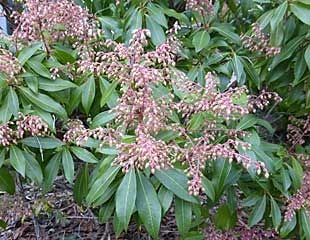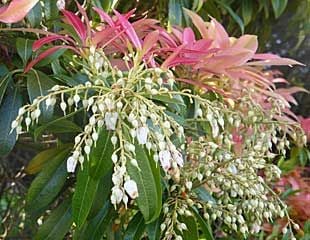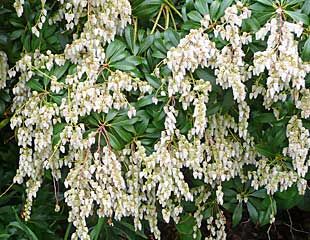
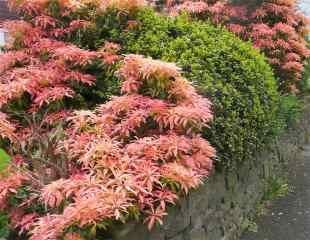
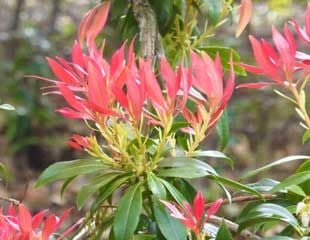
How to grow Pieris
Pieris is an attractive and easy to grow showy spring Shrub. The most commonly grown and popular variety is Pieris japonica, illustrated above, which has varieties such as 'Firecrest' and ' Mountain Fire'. Pieris has bright red coloured new growth in the spring, which fades to a subtle pink and finally green. Many varieties of Pieris have long white flowers in the spring. The shape and mass of white flowers gives Pieris its common name of Lily of the Valley bush.
Pieris is an ideal shrub. It is evergreen providing structure and colour all year round, and with several months of interest starting with the colourful red spring growth followed by attractive flowers. The new red growth appears in late February, and throughout March when the growth takes up colour and is at its brightest, and whilst that fades lovely flowers appear, usually, but not always white, in April and early May. Pieris requires no maintenance, and the only growing requirement is to be planted in acid soil.
Pieris grow to various sizes and some varieties can be very large; checking the size of a variety is an important planting point. The image lower down in this page shows a scale shot of Pieris illustrating how tall it can grow and the overall size of some varieties of mature Pieris.
Frost can damage the young red growth, although it is fully hardy, and it is best to plant Pieris out of chilling winds. Pieris is tolerant of semi-shade and of most garden conditions. Pieris look good planted with other acid loving shrubs such as Rhododendrons and Camellia to create a low maintenance shrub border.
Pieris do not require routine pruning. You can prune the shrub if needed to tidy up any spindly branches or spent flowers. Prune in late spring after flowering.
The only essential requirement when growing any variety of Pieris is acid soil and, if feeding, an ericaceous feed only.
If Pieris is not the shrub for you, check out shrubs and bushes; spring flowering shrubs; summer flowering shrubs; shrubs with autumn and winter interest; and evergreen shrubs.
If you need cover fast, take a look at Fast Growing Evergreen Shrubs for more planting ideas.
Different Types of Pieris to Grow

There are large varieties of Peiris, which is why checking the variety and label is important. Some varieties, such as P. Formosa can grow up to 6 metres which is really a tree, not a shrub.
P. japonica is a smaller variety which has the RHS award of garden merit and grows up to 2.5 -4 metres (8-12 ft) with a similar spread. It is fully hardy and has white flowers illustrated in the images above left and right.
Pieris japonica 'Debutante' is a more compact form, classified as dwarf growing up to 1 metre in around 10 years. Ideal if you want a small shrub which stays that way.
P. japonica 'Valley Valentine' illustrated below left has very attractive dusky red/dark mauve flowers. It is a large variety which grows to around 1.5 -2.5 metres in 10 years. Again, fully hardy H5 which is tolerant of low temperatures to -15c.
There are plenty of smaller varieties, such as P. japonica 'Compacta' with fragrant, white blooms in spring and is a heavy-flowering dwarf form. Also P. 'Flaming Silver' AGM with variegated foliage enhanced each spring with golden-red new growth. This is another smaller variety barely 2 metres in 10 years.
P. Forest flame illustrated below is a popular variety, and displays bright red foliage turning pink with age and then white flowers it will grow up to 4m (12')

The white flowers appear in the spring after the red foliage and are attractive to bees. The nectar-rich flowers are a good source of food for bees. Once established, it is reasonably drought and deer resistant. Like all shrubs it will require very regular watering for the first 12+ months to get fully established. The most common cause of shrubs failing to thrive is a lack of water.
The smaller varieties are suitable for growing in containers, especially useful if you do not have acid soil. In addition to ericacious compost grit in the container will help drainage.
P. japonica 'valley valentine' and P. 'forest flame
